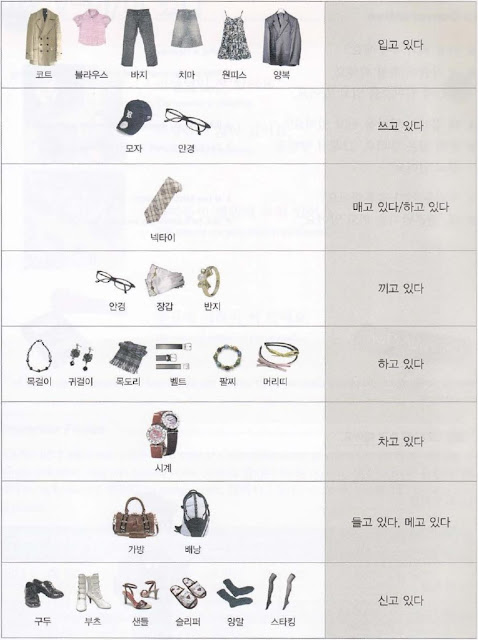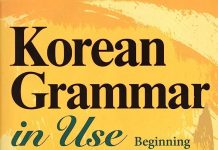 목걸이와 귀걸이를 하고 있어요.
목걸이와 귀걸이를 하고 있어요.
I’m wearing a necklace and earrings.
블라우스를 입고 있어요.
I’m wearing a blouse.
치마를 입고 있어요.
I’m wearing a skirt.
부츠를 신고 있어요.
I’m wearing boots.
안경을 쓰고/끼고 있어요.
I’m wearing glasses.
장갑을 끼고 있어요.
I’m wearing gloves.
양복을 입고 있어요.
I’m wearing a suit.
가방을 들고 있어요.
I’m carrying a briefcase.
구두를 신고 있어요.
I’m wearing shoes.
Grammar Focus:
When used with verbs that express pitting on or taking off something, such as 입다 (to wear clothes) 신다 (to wear shoes/socks), 쓰다 (to wear a hat/glasses), 끼다 (to wear a ring/gloves), and 벗다 (to take off). -고 있다 means the result of the action has continued in that state until the present.
It corresponds to ‘is -ing’ in English. The same meaning can also be expressed by using the past tense form -았/었어요 to indicate a state of completed action.
• 치마를 입고 있어요. = 치마를 입었어요. I’m wearing a skirt.
• 안경을 쓰고 있어요. = 안경을 썼어요. I’m wearing glasses.
 Conversation:
Conversation:
A: 하영 씨가 누구예요? Who is Hayeong?
B: 저 사람이 하영 씨예요. 빨간색 원피스를 입고 있어요.
That person (over there) is Hayeong. She’s wearing a red dress.
A: 왜 집에서 양말을 신고 있어요?
Why are you wearing socks inside your house?
B: 우리 집은추워요. 그래서 양말을 신고 있어요.
Our house is cold. So I’m wearing socks.
A: 이민우 씨가 결혼했어요? Is Lee Minu married?
B: 네, 결혼반지를 끼고 있어요. Yes, he’s wearing a wedding ring.
>> Full of ‘Korean grammar in use – Beginner’: Click here
>> Fanpage: Say Hi Korean


![[Korean grammar] ‘ㅅ’ 불규칙 (Irregular Conjugation)](https://sayhikorean.com/wp-content/uploads/2021/10/112.1.jpg)
![[Korean grammar] ‘ㅎ’ 불규칙 (Irregular Conjugation)](https://sayhikorean.com/wp-content/uploads/2021/10/111.1.jpg)
![[Korean grammar] ‘르’ 불규칙 (Irregular Conjugation)](https://sayhikorean.com/wp-content/uploads/2021/10/110.1.jpg)
![[Korean grammar] ‘ㄷ’ 불규칙 (Irregular Conjugation)](https://sayhikorean.com/wp-content/uploads/2021/10/109.1.jpg)
![[Korean grammar] ‘ㅂ’ 불규칙 (Irregular Conjugation)](https://sayhikorean.com/wp-content/uploads/2021/10/108.1.jpg)
![[Korean grammar] ‘ㄹ’ 불규칙 (Irregular Conjugation)](https://sayhikorean.com/wp-content/uploads/2021/10/107.1.jpg)
![[Korean grammar] ‘ㅡ’ 불규칙 (Irregular Conjugation)](https://sayhikorean.com/wp-content/uploads/2021/10/106.1.jpg)
![[Korean grammar] Indirect Quotation Contracted Forms: -대요, -래요, -재요, -냬요](https://sayhikorean.com/wp-content/uploads/2021/10/105.1.jpg)
![[Korean grammar] Indirect Quotations](https://sayhikorean.com/wp-content/uploads/2021/10/104.1.jpg)
![[Korean grammar] Direct Quotations: ‘Quoted speech’ + 하고/라고 + V](https://sayhikorean.com/wp-content/uploads/2021/10/103.1.jpg)
![[Korean grammar] A/V-(으)ㄴ/는데요 Additional Endings](https://sayhikorean.com/wp-content/uploads/2021/10/102.1.jpg)